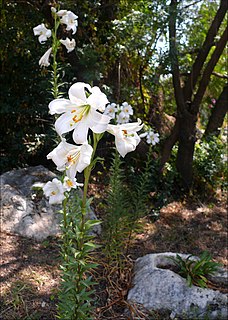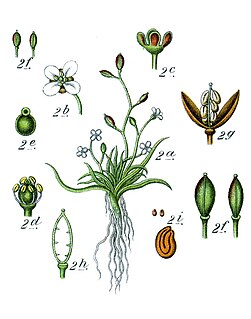
Senecio is a genus of flowering plants in the daisy family (Asteraceae) that includes ragworts and groundsels. The scientific name, Senecio, means "old man".

Jasmine is a genus of shrubs and vines in the olive family (Oleaceae). It contains around 200 species native to tropical and warm temperate regions of Eurasia, Africa, and Oceania. Jasmines are widely cultivated for the characteristic fragrance of their flowers. A number of unrelated plants contain the word "jasmine" in their common names.

Silphium is a genus of North American plants in the sunflower tribe within the daisy family.

Anacyclus is a genus of plants in the family Asteraceae described by Linnaeus in 1753. Annuals or herbaceous perennials, they are cultivated for their fern-like leaves on creeping, radiating stems and daisy-like flowers. They are frost-hardy but may tolerate winter temperatures below −5 °C (23 °F) if grown in well-drained soil.

Anacyclus pyrethrum, the pellitory, Spanish chamomile, Mount Atlas daisy, or Akarkara, is a species of flowering plant in the daisy family Asteraceae. It is native to Mediterranean Europe and parts of North Africa, but also naturalised in other parts of Europe, India and Pakistan. This herbaceous perennial resembles chamomile species in habitat and appearance.

Lilium candidum, the Madonna lily, or white lily is a plant in the true lily family. It is native to the Balkans and Middle East, and naturalized in other parts of Europe, including France, Italy, and Ukraine, and in North Africa, the Canary Islands, Mexico, and other regions. It has been cultivated since antiquity, for at least 3,000 years, and has great symbolic value since then for many cultures. It is susceptible to several virus diseases common to lilies, and especially to Botrytis fungus. One technique to avoid problems with viruses is to grow plants from seed instead of bulblets.

The creeping zinnias are plants belonging to the sunflower family. They are native to mostly to Mexico, with a few species in Central America, South America, and the Southwestern United States.

Campanula carpatica, the tussock bellflower or Carpathian harebell, is a species of flowering plant in the family Campanulaceae, native to the Carpathian Mountains of Central Europe. It is a low-growing herbaceous perennial, with long stems bearing solitary blue bell-shaped flowers. It was introduced to the Royal Botanic Garden at Kew in 1774 by Nikolaus Joseph von Jacquin. Several cultivars in shades of white, blue, pink and purple, have been developed for garden use.

Spartium junceum, known as Spanish broom, rush broom, or weaver's broom, it is a species of flowering plant in the family Fabaceae and the sole species in the genus Spartium. It is closely related to the other brooms.

Anthemis cotula, also known as stinking chamomile, is a flowering annual plant with a noticeable and strong odor. The odor is often considered unpleasant, and it is from this that it gains the common epithet "stinking". In pre-colonial times, its distribution was limited to the Old Continent and Africa; though it was established in most of Europe, it was not present in Finland, Ireland, or the northernmost reaches of Scotland, in spite of the fact that these countries feature climatic regions favorable to this plant and are in proximity to countries where the species is native, such as Russia, Estonia, Lithuania and England. It has successfully migrated to the New Europes where it can be found growing in meadows, alongside roads, and in fields.

Andropogon is a widespread genus of plants in the grass family, native to much of Asia, Africa, and the Americas, as well as southern Europe and various oceanic islands.

Anthemis arvensis, also known as corn chamomile, mayweed, scentless chamomile, or field chamomile is a species of flowering plant in the genus Anthemis, in the aster family. It is used as an ornamental plant.

Eleocharis quinqueflora is a species of spikesedge known by the common names fewflower spikerush and few-flowered spike-rush. It is widespread across Europe, North Africa, northern Asia, and North America. There are also isolated populations in Argentina and Chile.

Senecio leucanthemifolius is a plant common in sea-side in Mediterranean area.

Mimulopsis is a genus in the flowering plant family Acanthaceae with about 30 species native to tropical Africa and Madagascar.

Subularia is a genus of plants in the family Brassicaceae. Subularia species are annual herbs that grow in moist or even flooded soils. There are only two species of the genus: Subularia aquatica, which is widespread in North America and Europe; and Subularia monticola, from Africa mountains. Awlwort is a common name for plants in this genus.

Anacyclus valentinus is the type species for the genus Anacyclus in the tribe Anthemideae and family Asteraceae.
Oonopsis, false goldenweed, is a genus of flowering plants in the daisy family.
Toiyabea is a genus of North American plants in the aster tribe within the daisy family. The genus is named for the Toiyabe Mountains in the US state of Nevada. The only known species is Toiyabea alpina, the alpine serpentweed, native to the Toiyabe and Toquima Mountains of central Nevada.
Xylothamia, the desert goldenrods, is a genus of flowering plants in the daisy family, Asteraceae. Until 2003, it was held to contain nine species of shrubs native to deserts of Mexico and the southwestern United States. However, it seems to contain at least two groups. Four species are related to Gundlachia and may be moved to that genus. The relationships of the other five species is not quite as clear. All nine species do belong in the subtribe Solidagininae.
















